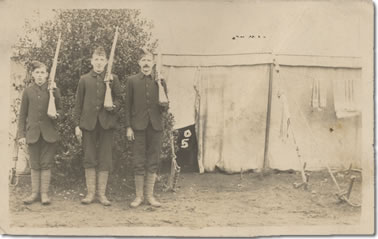
The Army Photograph showing men volunteering to fight in the First World War. Image taken from The Times History of the War Vol V, (DUL ref: XX+355.9403) The Growth of Army When war broke out in 1914 Britain had a small, professional army consisting of 125,000 officers and men. This was easily dwarfed by both her allies and her enemies. France had a standing army of 700,000 with the ability to grow to 4.2 million by calling up Territorials and Reserves; Germany had the immediate service of 840,000 men with the ability to call up 5 million; Russia’s standing army alone was 1.3 million; even Austria-Hungary had a permanent army of 415,000. It was very clear that Britain desperately needed to increase the size of her Armed Forces. Kitchener was given permission to ask for volunteers to join the ‘New Army’ and by the end of 1914 over 1 million men had answered his call. As the fighting continued and casualties rose, however, more and more men were needed. As a result conscription was introduced in January 1916. At first only single men aged 18-?? were called up, this was later extended to all single men up to the age of 41 and by 1918 all men between the ages of 18 and 51 could be called upon to serve. The net result was that by the end of the war there were over 2 million officers and men serving in the infantry alone and over 9 million men and women had passed through the armed forces during the course of the conflict. The New Army  Photograph showing new recruits dressed in emergency blue uniforms. Image courtesy of Keith Bartlett. The men recruited into Kitchener’s New Army were, undoubtedly, a welcome relief. Casualty figures were high – between 1914 and 1916 Britain had suffered over 512,000 casualties – and men were needed to replace the dead and wounded. However, the sudden influx of so many recruits caused many problems. Even such basic requirements as kitting them out with uniform and equipment proved difficult. Many of the new recruits arriving at the training camps had to wear their own clothes, others wore old-style red jackets dating back to the Boer War, some were issued with emergency blue uniforms, whilst others were kitted out in uniforms bought by public subscription. Training too was a problem. All the serviceable artillery pieces and rifles had been shipped to France forcing the recruits to train with obsolete weapons or mock-ups. Finding officers to train the men was also difficult: most of the regular officers and NCOs were serving overseas. The government responded by calling up officers on the Reserve Lists, using men from the OTC and any British Indian Army officer it could find. Perhaps the greatest shortage, however, was time. Kitchener though that his New Army would be able to train until late 1916 or even early 1917 but this proved impossible. The demands on manpower were so great that the most of the New Army found itself fighting by the end of 1915. Structure of the Army  Diagram showing the typical structure of an infantry division. When we think of the First World War it is all too easy to forget that not everyone fighting was in the Army. Thousands of men and boys also served in the Navy, whilst others served in the Royal Flying Corps and Royal Naval Air Service (which were amalgamated into the Royal Air Force in April 1918). However, most men were drafted to fight in the Army. The structure of the Army, as you might expect, was very complex. The main divisions were Cavalry, Artillery, Infantry and Engineers but there were many other corps such as the Service Corps, Medical Corps, Veterinary Corps, Signals Corps, Pay Corps etc. Each was organised in its own way and had a very distinct role to play. An example of how the infantry operated can be seen opposite. Many of the men volunteering to fight in the First World War did so on the understanding that they would be fighting with their friends and neighbours. This led to the formation of the famous ‘Pals’ Battalions, where men from one community all served together. Although this was initially thought to be a good idea, the notion fell out of favour as the war progressed and whole sections of communities were either killed or injured in combat. One prime example is 18 Durham Light Infantry, known as the Durham Pals, who on the 1st day of the Battle of the Somme, lost 58% of their Battalion in casualties. The impact of these losses on the home towns, villages and communities was devastating. Casualties  Photograph showing a First World War ambulance. (DUL ref: Misc Photo Album 2)
There is no consensus on casualty figures for the First World War and some of the estimates vary widely. There is even no agreement on what should be included in the casualty figures. As a result, the figures given below should be taken as an approximate guide to the casualties suffered by the main participants.
|